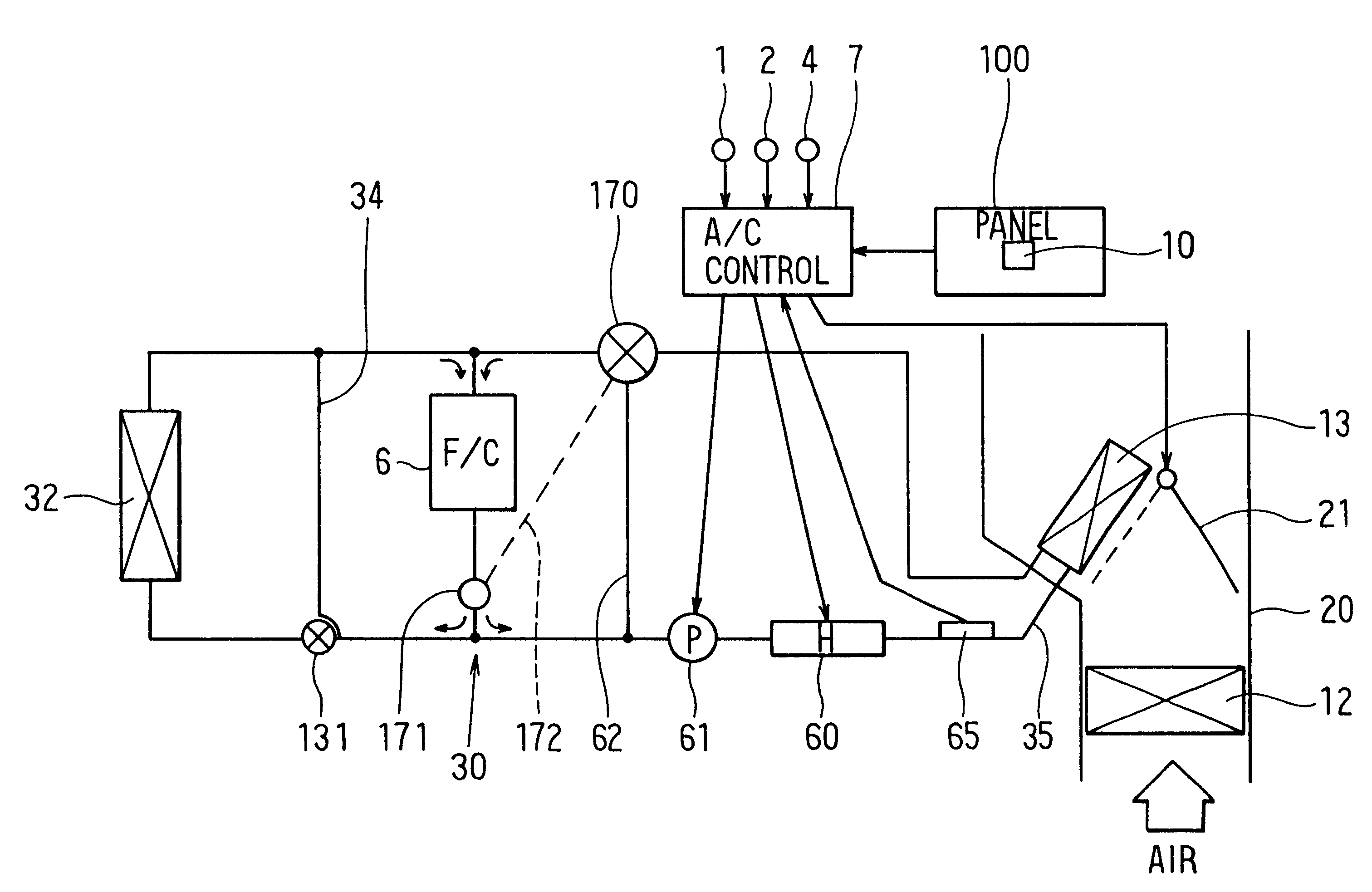Vehicle air conditioner with heating capacity control of cooling water circuit
a technology of cooling water circuit and heating capacity control, which is applied in vehicle heating/cooling devices, transportation and packaging, and electrical generators. it can solve the problems of insufficient heating effect, insufficient heat quantity, and ineffective use of unnecessary heat discharged from the engin
- Summary
- Abstract
- Description
- Claims
- Application Information
AI Technical Summary
Benefits of technology
Problems solved by technology
Method used
Image
Examples
first embodiment
A first preferred embodiment of the present invention will be now described with reference to FIGS. 1-4. In the first embodiment, the present invention is typically applied to an air conditioner for a fuel-cell powered vehicle. As shown in FIG. 1, a fuel cell system (F / C) 6 that is an equipment needed to perform a temperature control is connected to a cooling water circuit 30. The fuel cell system 6 has therein a water pump (not shown) so that cooling water for cooling the fuel cell system 6 is circulated in the cooling water circuit 30.
A radiator 32, for radiating a surplus heat of cooling water to an outside of a passenger compartment, is disposed in the cooling water circuit 30. The cooling water circuit 30 has a first cooling water passage 34 through which cooling water bypasses the radiator 32 when it is unnecessary to radiate heat of cooling water to the outside of the passenger compartment. A three-way valve 31 for distributing cooling water from the fuel cell system 6 is dis...
third embodiment
In the third embodiment, as shown in FIG. 6, a control valve 80 is used instead of the above-described control valve 40. The control valve 80 has therein a first inlet 81 from which cooling water from the fuel cell system 6 flows into the control valve 80, a second inlet 83 from which cooling water from the heater core 13 flows into the control valve 80, and an outlet 84 from which cooling water in the control valve 80 flows toward the fuel cell system 6. A valve body 85 is rotatably disposed in the control valve 80, so that a first passage 90 from the first inlet 81 to the outlet 84, and a second passage 91 from the second inlet 83 to the outlet 84 are defined in the control valve 80.
The control valve 80 has a controller 88 made of a servomotor. The valve body 85 is controlled by the controller 88 to be rotated by a predetermined rotation angle. By adjusting a rotation angle of the valve body 85, an opening area ratio between the first passage 90 and the second passage 91 can be ad...
fourth embodiment
In the fourth embodiment, the fuel cell system 6 is connected to the cooling water circuit 30 as shown in FIG. 7. The cooling water circuit 30 has a first cooling water passage 34 through which cooling water circulates at a left side circuit of the fuel cell system 6 in FIG. 7, and a second cooling water passage 35 through which cooling water circulates at a right side circuit of the fuel cell system 6 in FIG. 7, including the heater core 13. A water pump (not shown) is provided within the fuel cell system 6 so that cooling water circulates in the cooling water circuit 30. By cooling water circulating in the cooling water circuit 30, temperature of the fuel cell system 6 is controlled (cooled) in a suitable temperature range (e.g., 72-80.degree. C.) where the electrical-power generating effect of the fuel cell system 6 can be made suitable. Generally, the fuel cell system 6 operates normally in the suitable temperature range (e.g., 72-80.degree. C.).
The radiator 32 is disposed so th...
PUM
| Property | Measurement | Unit |
|---|---|---|
| temperature | aaaaa | aaaaa |
| temperature | aaaaa | aaaaa |
| temperature | aaaaa | aaaaa |
Abstract
Description
Claims
Application Information
 Login to View More
Login to View More - R&D
- Intellectual Property
- Life Sciences
- Materials
- Tech Scout
- Unparalleled Data Quality
- Higher Quality Content
- 60% Fewer Hallucinations
Browse by: Latest US Patents, China's latest patents, Technical Efficacy Thesaurus, Application Domain, Technology Topic, Popular Technical Reports.
© 2025 PatSnap. All rights reserved.Legal|Privacy policy|Modern Slavery Act Transparency Statement|Sitemap|About US| Contact US: help@patsnap.com



